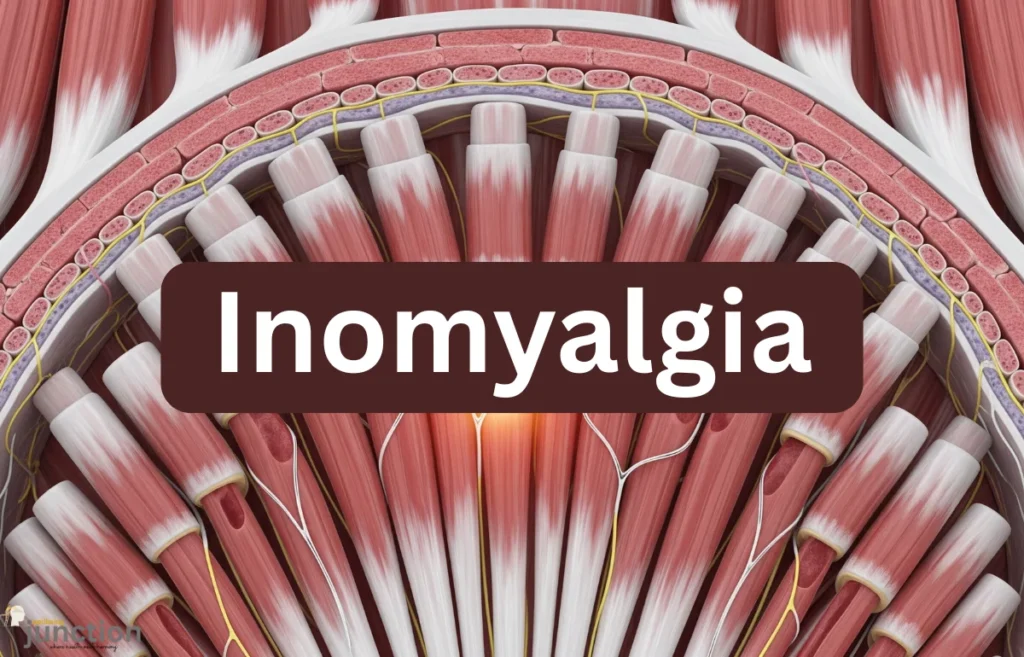Inomyalgia is a term that has emerged in discussions around chronic muscle pain but is not yet widely recognized in mainstream medical literature. The word “inomyalgia” combines “ino,” which refers to muscle fibers, and “myalgia,” meaning muscle pain. This condition is believed to represent a form of chronic muscle pain that originates in the deeper tissues or internal fibers of the muscles. In this article, we will explore the concept of inomyalgia, its symptoms, causes, diagnostic challenges, treatment options, and its potential future as a distinct classification in the world of muscle-related disorders.
What Is Inomyalgia?
Inomyalgia is a term that may not be found in textbooks, but it can help to describe certain unexplained cases of chronic muscle pain. The word itself can be broken down into two parts:
-
Ino: From the Greek word inos, which means fiber or sinew, relating to the internal muscle fibers or deeper tissues of the muscles.
-
Myalgia: A term used to refer to muscle pain, often associated with a wide range of musculoskeletal conditions.
While the term inomyalgia is not yet officially recognized by the medical community, it provides a way of understanding pain that may not be related to surface-level muscle discomfort but rather to deep muscle structures and internal tissue. It could be used to describe a category of muscular pain disorders that doesn’t neatly fit into existing classifications like fibromyalgia or myofascial pain syndrome.
Symptoms of Inomyalgia
As an emerging concept in medical literature, inomyalgia has yet to be fully defined, but based on its components, it is believed to share several symptoms with chronic muscle pain disorders. These symptoms can range in intensity and may have a significant impact on daily life.
Common Symptoms of Inomyalgia
-
Persistent Muscle Pain: The most common symptom is continuous or chronic muscle pain. This pain can be dull, throbbing, or deep-seated, often felt in the larger muscle groups such as the back, shoulders, and thighs.
-
Muscle Fatigue and Weakness: People with inomyalgia may experience fatigue and weakness in their muscles, even after mild exertion.
-
Deep Tissue Tenderness: Unlike superficial muscle pain, inomyalgia is believed to affect deeper muscle tissues, resulting in tenderness that can be difficult to pinpoint.
-
Difficulty with Physical Exertion: Activities that require prolonged use of muscles may become difficult or impossible due to discomfort and muscle weakness.
-
Sleep Disturbances: Chronic muscle pain can interfere with sleep, leading to poor rest and further exacerbating muscle discomfort.
-
Tender Points: These areas of pain may be found in specific muscle groups, much like the trigger points seen in myofascial pain syndrome.
Impact on Daily Functioning
Individuals suffering from inomyalgia often report difficulties performing daily activities. The persistent muscle pain can make it challenging to maintain posture, carry out physical tasks, and even concentrate on mental tasks. Over time, untreated inomyalgia may result in a decline in mobility and a reduced quality of life, highlighting the importance of identifying and managing this condition early.
Possible Causes of Inomyalgia
Several factors could contribute to the development of inomyalgia. While not yet fully understood, the following causes are believed to play a role in muscle dysfunction and chronic pain:
1. Muscle Overuse and Repetitive Strain
Overuse of specific muscle groups, often through repetitive motion or physically demanding work, can lead to microtears in muscle fibers. These tiny tears cause inflammation and discomfort, which, when left untreated, may result in chronic pain. Repetitive strain is a well-known trigger for muscle disorders, and inomyalgia could be its more specific categorization.
2. Poor Posture and Sedentary Lifestyle
Long periods of poor posture, such as slouching or sitting for extended hours, can lead to stiffness and discomfort in the muscles. Additionally, a sedentary lifestyle with minimal physical activity can cause muscles to weaken, leading to internal muscle tension that could be linked to inomyalgia.
3. Stress and Psychological Factors
Mental and emotional stress can contribute to physical muscle tension. Stress often causes the muscles to contract, particularly around the neck, shoulders, and back. Prolonged muscle tension due to stress could lead to inflammation of muscle fibers, triggering chronic pain.
4. Muscle Imbalances and Weakness
Muscle imbalances, where certain muscle groups are stronger or weaker than others, can place additional strain on deeper tissues, leading to pain and discomfort. Over time, these imbalances may result in inomyalgia-like symptoms.
Diagnosing Inomyalgia
Diagnosing inomyalgia can be challenging because it does not have clear diagnostic criteria yet. However, healthcare providers can assess patients based on the symptoms described above and use a combination of the following:
-
Physical Examination: Doctors may examine tender points in the muscles and assess muscle strength and flexibility.
-
Medical History Evaluation: A thorough history of any previous injuries, lifestyle habits, or occupations involving repetitive movements can be helpful.
-
Imaging: While imaging is unlikely to detect inomyalgia directly, it can help rule out structural issues, such as herniated discs or joint problems.
-
Blood Tests: These can help rule out other potential causes, such as autoimmune conditions that might mimic muscle pain.
Since inomyalgia overlaps with other conditions, it may be diagnosed as:
-
Myofascial Pain Syndrome
-
Chronic Muscle Strain
-
Soft Tissue Inflammation
-
Unclassified Muscle Pain Disorders
Treatment Options for Inomyalgia
Although inomyalgia itself isn’t a well-defined condition in medical practice, its symptoms can be managed through various treatment methods. Treatment typically aims to reduce muscle pain, improve function, and prevent further muscle damage.
1. Physical Therapy and Exercise
Physical therapy is a cornerstone of treatment for muscle-related pain. A physical therapist can guide patients through exercises that help stretch and strengthen affected muscles, improving flexibility and reducing pain. Posture correction may also be part of the therapy plan, especially for those with poor posture contributing to muscle strain.
2. Medications
Several medications can be used to manage symptoms of inomyalgia, including:
-
NSAIDs (Non-Steroidal Anti-Inflammatory Drugs): These medications help reduce inflammation and alleviate pain.
-
Muscle Relaxants: These can offer assistance soothe muscle fits and tension.
-
Pain Relief Creams: Topical treatments that help soothe sore muscles.
-
Low-Dose Antidepressants: These can be prescribed in some cases for chronic pain management, as they can alter pain pathways in the brain.
3. Lifestyle Modifications
Changes in daily habits can also help manage inomyalgia. Recommendations include:
-
Improving Ergonomics: Adjusting posture while working or sitting to prevent strain on the muscles.
-
Regular Exercise: Engaging in activities like walking, swimming, or yoga that promote overall muscle health.
-
Stress Management: Techniques such as meditation, deep breathing exercises, or therapy to reduce muscle tension caused by stress.
-
Heat and Cold Therapy: Alternating hot and cold compresses can help relieve muscle pain and reduce inflammation.
Future Outlook: The Growing Recognition of Inomyalgia
As chronic muscle pain continues to be a widespread concern, the need for more precise diagnostic categories becomes increasingly apparent. Inomyalgia might emerge as a more focused classification within the field of musculoskeletal disorders, providing clearer identification and treatment options for patients experiencing deep tissue pain. Ongoing research will be essential in determining whether inomyalgia is a distinct condition or if it will remain as part of existing pain disorders like fibromyalgia or myofascial pain syndrome.
Frequently Asked Questions (FAQs)
1. Is inomyalgia the same as fibromyalgia?
No, inomyalgia specifically focuses on deep muscle pain, while fibromyalgia affects both muscles and connective tissues, often accompanied by fatigue and mental fog.
2. How is inomyalgia diagnosed?
Inomyalgia is not officially recognized, so it may be diagnosed based on symptoms similar to other muscle pain conditions like myofascial pain syndrome or chronic muscle strain.
3. What treatments are available for inomyalgia?
Treatment includes physical therapy, medications like NSAIDs and muscle relaxants, and lifestyle changes such as stress management and regular exercise.
4. Can poor posture cause inomyalgia?
Yes, poor posture can lead to muscle strain, especially in deeper tissues, and may contribute to the development of inomyalgia.
5. Is inomyalgia preventable?
While some causes are unavoidable, maintaining good posture, managing stress, and engaging in regular physical activity can help prevent or reduce the severity of inomyalgia.
Conclusion
Inomyalgia is an emerging term that may one day serve as a critical classification for certain forms of chronic muscle pain. Though not officially recognized yet, its focus on deep muscle tissue pain offers a more refined understanding of muscle-related discomfort. As awareness grows and research continues, inomyalgia could provide clearer identification and more targeted treatments for those suffering from unexplained muscle pain.

I’m Salman Khayam, founder of Wellbeing Junction. I synthesize trusted information from research and expert guidance to create clear articles across health, wellness, and lifestyle topics.
Disclaimer: Content is for informational purposes only and is not medical advice. Consult a qualified expert regarding personal health or specialized questions.


